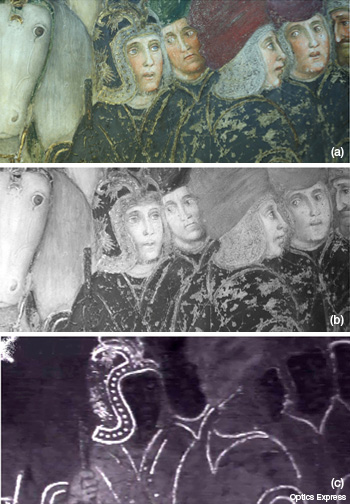
Part of the fresco by the Zavattaris in Theodelinda’s Chapel. The art works from the 1400s feature different fresco techniques, gold and silver decorations, and reliefs. Color photography (a), and imaging in the near-infrared (b), compared to the thermal quasi-reflectography image (c).
A team of Italian researchers has developed a method of imaging art using wavelengths of light in the mid-infrared (3 to 5 µm) range, which they expect to expand the toolbox for art restoration. People studying and restoring art already work with many optical methods that use the near-infrared (IR) and/or lasers to examine the subsurface, analyze pigments and look for details not visible to the naked eye—but mid-IR imaging can offer unique information.
Claudia Daffara and others at the University of Verona, University of Aquila and the National Institute of Optics (Italy) developed thermal quasi-reflectography (TQR), a noninvasive and simple in-situ imaging method (Opt. Express 20, 14746). It uses reflected light from the mid-IR to reveal details that are not visible using either the more-established near-IR or standard thermographic imaging. They demonstrated the system on two famous artworks: Zavattari's frescos in the Chapel of Theodelinda and Piero della Francesca "The Resurrection." "For mural paintings, the use of the mid-infrared regions reveals crucial details," said Daffara. "This makes TQR a promising tool for the investigation of these artworks."
Unlike thermography, which images the mid-IR light emitted by different pigments, the new method looks for mid-IR light reflected from the painting. The mid-IR source is an under-powered halogen lamp shining at the painting. A cooled mid-IR camera captures reflected light.
The group found that gold and silver reflect more brightly than in the near-IR. They were also able to differentiate between pigments that look similar in the near-IR, as well as distinguishing painting methods and retouched areas. The researchers are looking into mid-IR spectroscopy to obtain more useful information.
Article co-author Dario Ambrosini of the University of Aquila states: "This novel method represents a powerful yet safe tool for artwork diagnostics."
